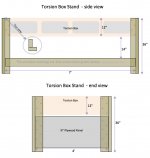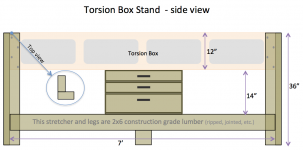I'm building a new workbench and I'm sold on a torsion box surface.
Here are a few thoughts that went into the attached draft (image).
Today, it'll be a stand alone work bench but I'm making it the same height as my table saw (36.25") just in case I decide to re-arrange the shop one day.
My concerns:
I was thinking that the grid to support that shelf would be 2x4 material unless y'all think that going 2x6 would enhance the stability of the undercarriage and somehow contribute to anti-racking along the long axis.
On the end view, you'll notice plywood panel instead of a skinny stretcher. I figure that'll take out the racking for that axis of the undercarriage but does anyone have predictions about performance on the long axis?
The one nice thing about the deep torsion box is all of that vertical contact between the legs and the box. I'm hoping the rigidity stemming from that element makes up for other possible shortcomings of the rest of the design.
Thoughts and suggestions pretty please?
TIA,
David in Washington
[attachimg=1]
Here are a few thoughts that went into the attached draft (image).
Today, it'll be a stand alone work bench but I'm making it the same height as my table saw (36.25") just in case I decide to re-arrange the shop one day.
- This will be a fairly sizable work top as I want this station to accommodate the task of sizing down 4x8 sheets into smaller pieces.
- The bench will have a wood vice and I may also mount my metals vice at one corner of the top (still thinking about that though).
- The depth of the torsion box might be a few inches too generous and may get slimmed down an inch or two. I don't want to be restricted on what tools and such I can store in the cubbies to keep the work surface clear.
My concerns:
- With the torsion box design, I'm not concerned about rigidity of the surface but I'm a little apprehensive about the undercarriage racking back and forth.
- Given the vice features of it, I'll be whacking, sawing, planing and the like so I want it to be sturdy.
- I'm trying to balance that need with also maximizing access to the lower shelf (located even with the 2x6 horizontal stretcher shown in the "side view") and the items I'll store there.
I was thinking that the grid to support that shelf would be 2x4 material unless y'all think that going 2x6 would enhance the stability of the undercarriage and somehow contribute to anti-racking along the long axis.
On the end view, you'll notice plywood panel instead of a skinny stretcher. I figure that'll take out the racking for that axis of the undercarriage but does anyone have predictions about performance on the long axis?
The one nice thing about the deep torsion box is all of that vertical contact between the legs and the box. I'm hoping the rigidity stemming from that element makes up for other possible shortcomings of the rest of the design.
Thoughts and suggestions pretty please?
TIA,
David in Washington
[attachimg=1]


